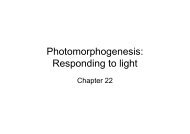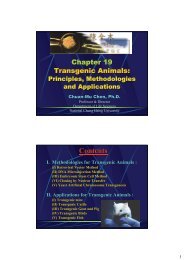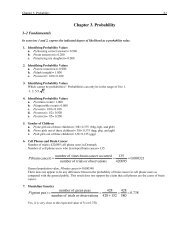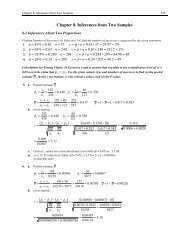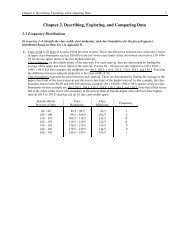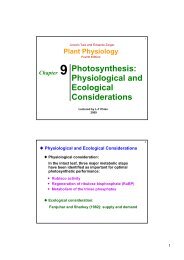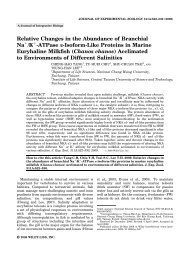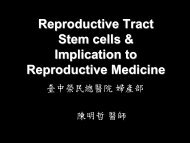Chapter 7. Hypothesis Testing with One Sample
Chapter 7. Hypothesis Testing with One Sample
Chapter 7. Hypothesis Testing with One Sample
Create successful ePaper yourself
Turn your PDF publications into a flip-book with our unique Google optimized e-Paper software.
228 <strong>Chapter</strong> 7: <strong>Hypothesis</strong> <strong>Testing</strong> <strong>with</strong> <strong>One</strong> <strong>Sample</strong>3. Effective TreatmentFirst, we check the requirements. We will assume that the sample is a simple random sample. The conditionsfor a binomial are satisfied. The sample size is 200 <strong>with</strong> the claim that the proportion of tree deaths for treatedtrees is less than 10%, making p = 0.10, so np = 200 × 0.10 = 20 and nq = 200 × 0.90 = 180. The requirementsare satisfied.The claim is that the proportion of tree deaths for treated trees is less than 10%, so this is a left-tailed test. Inthe sample, 16 of the trees died the following year. The sample proportion is p ˆ = x / n = 16 / 200 = 0.08.H 0 : p = 0.10H 1 : p < 0.10The test statistic is z = p ˆ − p 0.08 − 0.10= =−0.943pq 0.10 × 0.90n 200In a left-tailed test at the 0.05 significance level, the critical value is −z α=−z .05=−1.645.Since this is a left tailed test, the P-value is the area to the left of the test statistic. Using Table A-2, we findthat the P − value = 0.1736.We fail to reject the null hypothesis.There is not sufficient sample evidence to support the claim that the proportion of tree deaths for treated treesis less than 10%.4. X-Linked Recessive DisorderWe will test the claim that the method has lowered the proportion of boys who have the X-linked recessivedisorder. First, we check the requirements. We will assume that the sample is a simple random sample. Theconditions for a binomial are satisfied. The sample size is 40 <strong>with</strong> the claim that the proportion of boys whohave the X-linked recessive disorder is less than 50%, making p = 0.50, so np = 40 × 0.50 = 20 andnq = 40 × 0.50 = 20. The requirements are satisfied.The claim is that the proportion of boys who have the X-linked recessive disorder is less than 50%, so this is aleft-tailed test. In the sample, 15 of the boys had the disorder. The sample proportion isp ˆ = x / n = 15/ 40 = 0.375.H 0 : p = 0.50H 1 : p < 0.50The test statistic is z = p ˆ − ppqn0.375− 0.50= =−1.5810.50 × 0.5040In a left-tailed test at the 0.05 significance level, the critical value is −z α=−z .05=−1.645.Since this is a left tailed test, the P-value is the area to the left of the test statistic. Using Table A-2, we findthat the P − value = 0.0571.We fail to reject the null hypothesis.There is not sufficient sample evidence to support the claim that the proportion of boys who have the X-linkedrecessive disorder is less than 50%. Though the sample proportion was below the 50%, there is not sufficientevidence to make this claim.5. Are Consumers Being Cheated?The claim is that the mean volume of alcohol in the bottles is less than 12 oz, so this is a left-tailed test. Thesample size is n = 24, the sample mean is x = 11.4 , and the sample standard deviation is s = 0.62. Thesignificance level is not specified, so we use 0.05.H 0 : µ = 12H 1 : µ < 12The test statistic is t = x − µ 11.4 −12.0=s / n 0.62 / 24 =−4.741




